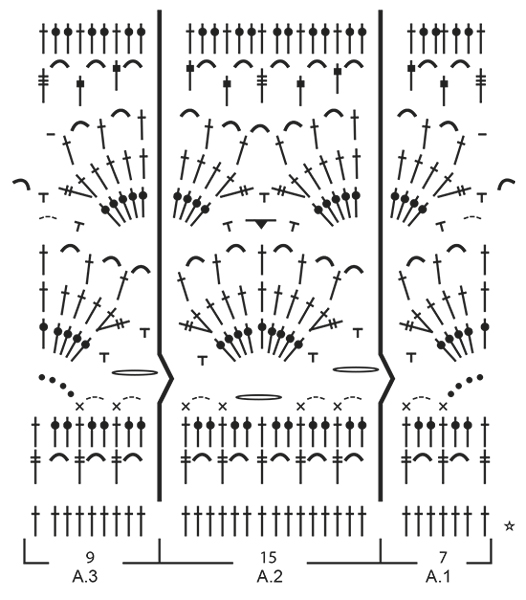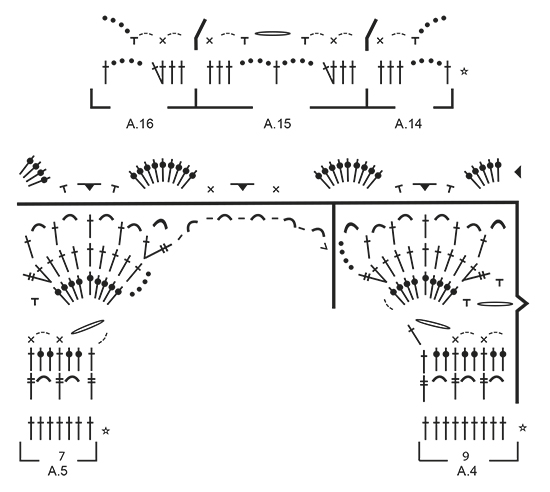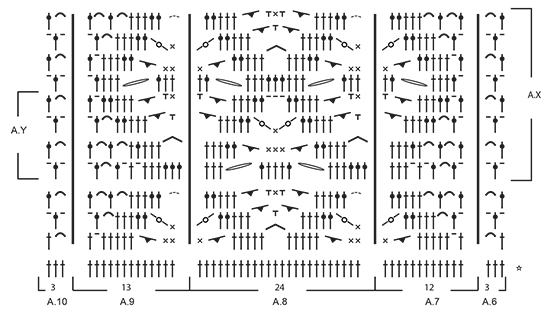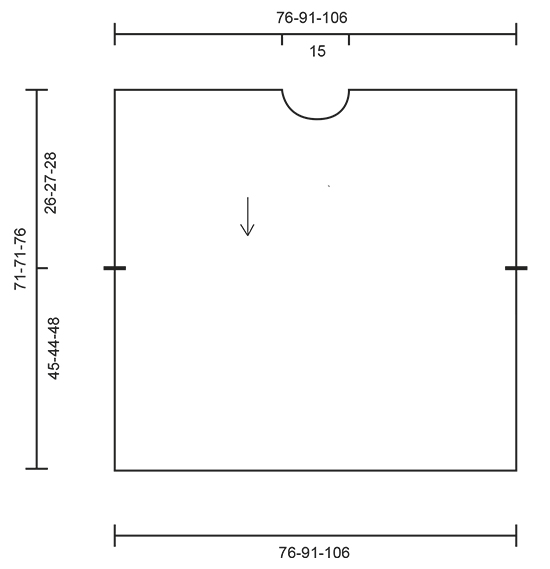Graceful Mermaid |
|||||||||||||||||||||||||||||||||||||||||||||||||||||||||||||||||||
|
|
|||||||||||||||||||||||||||||||||||||||||||||||||||||||||||||||||||
Crochet DROPS poncho with lace pattern, worked top down in ”Cotton Merino”. Size: S - XXXL.
DROPS 168-29 |
|||||||||||||||||||||||||||||||||||||||||||||||||||||||||||||||||||
|
PATTERN: See diagrams A.1 to A.16. CROCHET INFO: Replace first dc at beg of every dc row with 3 ch. Replace first tr at beg of every tr row with 4 ch. Replace first sc at beg of every sc row with 1 ch. ---------------------------------------------------------- PONCHO: The poncho is the same at the front and back with opening in the sides. Work back and forth, top down. RIGHT SHOULDER - FRONT PIECE: Work 80-98-117 ch on hook size 3.5 mm/E/4 with Cotton Merino. Turn and work 1 dc in 4th ch from hook (= 2 dc), 1 dc in each of the next 1-4-3 ch, * skip ch 1, 1 dc in each of the next 4 ch *, repeat from *-* the entire row = 63-78-93 dc (includes 2 edge sts in the side). Work next row (= from RS) as follows: READ CROCHET INFO! 1 dc in each of the first 2 dc (= edge sts), A.1 over the next 7 dc, A.2 over the next 45-60-75 dc (= 3-4-5 times), finish with A.4 over the next 9 dc. Work to and with 6th row. Put piece aside and work left shoulder. REMEMBER THE CROCHET GAUGE! LEFT SHOULDER - FRONT PIECE: Work first row as on right shoulder - front piece = 63-78-93 dc. Work next row (= from RS) as follows: A.5 over the first 7 dc, A.2 over the next 45-60-75 dc (= 3-4-5 times), A.3 over the next 9 dc, finish with 1 dc in each of the next 2 dc (= edge sts). Work to and with 6th row - NOTE: Fasten sl st at the end of A.5 in right shoulder so that the shoulder are fastened tog. Cut the yarn and beg to work from RS over both shoulders. FRONT PIECE: Continue on diagram (= 7th row), i.e. work next row (= from RS) as follows: 1 sc in each of the first 2 dc (= edge sts), A.1 over the next 7 dc, A.2 over the next 135-165-195 dc/ch (= 9-11-13 times) - NOTE: See last row in A.4/A.5 on how 7th row of A.2 is worked over the middle (A.4, 15 ch, A.5), A.3 over the next 9 dc, finish with 1 sc in each of the next 2 dc (= edge st). Work diagram A.1/A.2/A.3 1 time in total vertically (NOTE! You also begin and finish with 1 sc in first and last 2 sc's on row 8 and hereafter you work 1 dc in first 2 and last st on remaining rows) = 155-185-215 dc on last row. Work next row (= from WS) as follows: 1 dc in each of the first 2 dc, A.10 over the next 51-66-69 dc (= 17-22-23 times), A.9 over the next 13 dc, A.8 over the next 24-24-48 dc (= 1-1-2 times), A.7 over the next 12 dc, A.6 over the next 51-66-69 dc (= 17-22-23 times), finish with 1 dc in each of the next 2 dc. Work to and with 3rd row. Then work A.X 2-2-3-3 times in total vertically. Then work A.Y 1-1-0-0 times in total vertically. Work next row (= from RS) as follows: Work 1 dc in every dc/sc, 1 dc around every ch, 2 dc around every ch-space with ch 2, 3 dc around every ch-space with 3 ch and 4 dc around every ch-space with 5 ch = 155-185-215 dc. Work next row (= from WS) as follows: Work 1 dc in each of the first 2 dc, A.3 over the next 9 dc, A.2 over the next 135-165-195 dc (= 9-11-13 times), A.1 over the next 7 dc, finish with 1 dc in each of the next 2 dc. Work A.3/A.2/A.1 1 time in total vertically = 155-185-215 dc on last row. Work next row (= from RS) as follows: Work 1 dc in each of the first 2 dc, A.11 over the next 7 dc, A.12 over the next 135-165-195 dc (= 9-11-13 times), A.13 over the next 7 dc, finish with 1 dc in each of the next 2 dc. Work A.11/A.12/A.13 1 time in total vertically. Work next row (= from WS) as follows: Work 1 dc in each of the first 2 dc, A.16 over A.13, A.15 over A.12 and A.14 over A.11. Then work 4th and 5th row in A.1/A.2/A.3, i.e. work next row (= from RS) as follows: Work 1 dc in each of the first 2 dc, A.1 over A.14, A.2 over A.15, A.3 over A.16, finish with 1 dc in each of the next 2 dc. Fasten off. LEFT SHOULDER - BACK PIECE: Work in left shoulder on front piece but in opposite direction, beg from WS. Instead of working ch and first dc-row work as follows: Work 1 sc in each of the 78-93-108 dc. Then work as right shoulder - front piece. RIGHT SHOULDER - BACK PIECE: Work in right shoulder on front piece but in opposite direction, beg from WS. Instead of working ch and first dc-row work as follows: Work 1 sc in each of the 78-93-108 dc. Then work as left shoulder - front piece. BACK PIECE: Continue as on front piece. NECK EDGE: Beg on one shoulder, work as follows along the entire neck from RS: 2 sc around every dc-row, ch 1, 3 sc around every tr row/ch-space, 1 ch etc. Finish with 1 sl st in first sc. Fasten off. TWINED STRING: Cut 2 lengths Cotton Merino yarn of 6 metres each. Twine the strands tog until they resist, fold the string double so that it twines again. Tie a knot in each end and thread it through a hole in the side on front and back piece, approx. 26-27-28 cm / 10¼"-10⅝"-11" down from shoulder, tie a bow. Make another string and fasten it to the other side of poncho. |
|||||||||||||||||||||||||||||||||||||||||||||||||||||||||||||||||||
Diagram explanations |
|||||||||||||||||||||||||||||||||||||||||||||||||||||||||||||||||||
|
|||||||||||||||||||||||||||||||||||||||||||||||||||||||||||||||||||

|
|||||||||||||||||||||||||||||||||||||||||||||||||||||||||||||||||||

|
|||||||||||||||||||||||||||||||||||||||||||||||||||||||||||||||||||

|
|||||||||||||||||||||||||||||||||||||||||||||||||||||||||||||||||||

|
|||||||||||||||||||||||||||||||||||||||||||||||||||||||||||||||||||

|
|||||||||||||||||||||||||||||||||||||||||||||||||||||||||||||||||||
|
Have you made this or any other of our designs? Tag your pictures in social media with #dropsdesign so we can see them! Do you need help with this pattern?You'll find tutorial videos, a Comments/Questions area and more by visiting the pattern on garnstudio.com. © 1982-2024 DROPS Design A/S. We reserve all rights. This document, including all its sub-sections, has copyrights. Read more about what you can do with our patterns at the bottom of each pattern on our site. |
|||||||||||||||||||||||||||||||||||||||||||||||||||||||||||||||||||































































Comments / Questions (83)
Please see previous post: Respectfully, I have to disagree. You can see it in the picture based on number of pattern repeats. I spent a long time trying to figure out where I had made the mistake, only to discover that it wasn't me to begin with. I'm just trying to save anyone else the trouble. I apologize if it seems I'm being rude, but did anyone really check this out before responding that the stitch count in the patterns is correct? Just trying to help.
22.03.2016 - 22:02DROPS Design answered:
Dear Rebecca, I have may miscounted, your feedback has been forwarded to our Design team and they will check. Thank you. Happy crocheting!
23.03.2016 - 09:48I believe the stitch count is off. After you join the right and left shoulder pieces and finish working diagram A1/A2/A3 vertically for the "front piece" you have 185 sts for the smallest size. Not 155. I believe the pattern is not accounting for the sts that are added at the neck edge of A4/A5.
19.03.2016 - 14:48DROPS Design answered:
Dear Rebecca, you should get 155 sts after A.1,A.2 and A.3 on front piece after joining both shoulders, work over the sts on neckline as shown in 7th row in A.4-A.5. Happy crocheting!
21.03.2016 - 13:43Please see previous correspondence, this is a continuation: I'm unsure of how to handle the 2 edge stitches over the rest of the pattern- beyond the first couple of rows. This is not explained. Also, based on your previous answer, I believe there may be an error in the pattern. Under "right shoulder-front piece" work next row (=from RS) it says to dc in the first 2 edge sts. Since this is a tr row, shouldn't it say to tr these 2 sts instead of dc?
15.03.2016 - 21:47DROPS Design answered:
Dear Rebecca, your feedback has been forwarded to our Design team to check how these 2 edge sts are worked throughout the diagrams. Happy crocheting!
16.03.2016 - 08:52In the first couple rows of this project (right shoulder-front piece) the pattern has you set up 2 "edge stitches" in the side. Once you move on to following the chart, there is no mention of how to handle those 2 "edge sts" and they are not included in the chart. I see the note about the "crochet info" but that says to "replace the first stitch..." It doesn't address the 2 edge stitches. I'm stuck. And confused. Please help. Thank you.
14.03.2016 - 18:24DROPS Design answered:
Dear Rebecca, the 2 edge sts are worked at beg of row from RS (right shoulder front piece), they are not included in diagram, you crochet as follows from RS: 1 tr in each of the first 2 tr (= edge sts), A.1 over the next 7 tr, A.2 over the next 60-75-90 tr (= 4-5-6 times), finish with A.4 over the next 9 tr - and from WS: A.4 over the first 9 tr, A.2 4-5-6 times, A.1 over the next 7 tr and 2 edge sts. Happy crocheting!
15.03.2016 - 08:50Bonjour j aimerais savoir quel est le diagramme ax et ay je ne vois que des diagramme avec des chiffres. merci d avance
14.03.2016 - 00:40DROPS Design answered:
Bonjour Mme Colley, vous trouverez les diagrammes A.X et A.Y dans celui avec A.6, A.7, A.8, A.9 et A.10: les rangs de A.X sont encadrés à droite et ceux de A.7 sont encadrés à gauche. Bon crochet!
14.03.2016 - 10:00Hallo, ich häkle dieses Modell in der mittleren Größe - die Maschenprobe stimmt (91 cm), jedoch ist der Halsausschnitt sehr viel zu klein. Verstehe ich es richtig, dass die Verbindung vom linken zum rechten Schulterteil lediglich 15 Luftmaschen beträgt, oder habe ich etwas falsch verstanden? Vielen Dank und Gruß
11.03.2016 - 14:33DROPS Design answered:
Liebe Annette, der Abstand zwischen den Schultern beträgt 15 cm. zusammen mit der Tiefe des Ausschnitts (vorne und hinten) ergibt es die Ausschnittgrösse, die auf dem Foto und der Schnitteichnung gezeigt wird. Ich würde den Ausschnitt nicht grösser machen, damit der Poncho nicht über die Schultern rutscht.
14.03.2016 - 08:47Hoi! Ik ben begonnen aan deze poncho in de maat S/M. Ik kom echter na deel 1 uit op 185 stokjes ipv 155. Nu zag ik in het zweeds al een vraag over dit ontwerp op hetzelfde punt., misschien goed om het even na te kijken. Groetjes, Leonie
09.03.2016 - 15:29DROPS Design answered:
Hoi Leonie. Je begint en eindigt met 155 stk: 2 kantstk, A.1 (= 7 st), 135 st volgens A.2 (9 herhalingen), 9 st volgens A.3 en 2 kantstk. Het aantal verandert onderweg, maar in de laatste toer heb je weer hetzelfde aantal st.
11.03.2016 - 11:29Hej! jag Har börjat på denna poncho men får det inte att stämma. Har gjort hela första mönstret 1gång dvs början på framstycket och i strl L/XL ska det vara 185 stolpar och jag har många fler. Var kan jag ha gjort fel. Har tittat på mönstret flera gånger och hittar inget fel. MVH Anna
07.03.2016 - 17:01DROPS Design answered:
Hej Anna, Du virkar A.2 11 ggr och du har 15 st når du börjar diagrammet och även när du slutar diagrammet. Sätt i en märktråd efter varje rapport m 15 st, så ser du om du har rätt antal m i varje rapport. Lycka till!
08.03.2016 - 09:08Me encanta! Estaba deseando ver el patrón. Gracias!!!
13.02.2016 - 14:19Diese geniale Anleitung würde meine Kreativität für diese Saison vervollständigen. Ich warte ungeduldig darauf.
08.02.2016 - 08:50